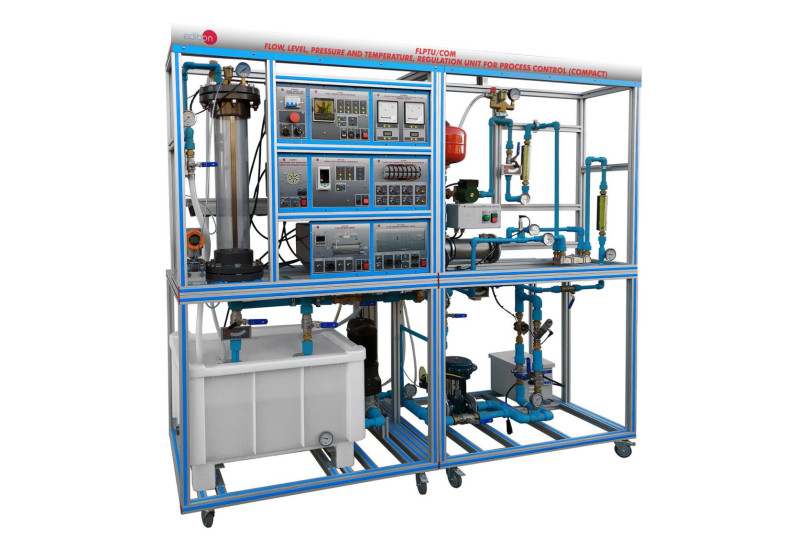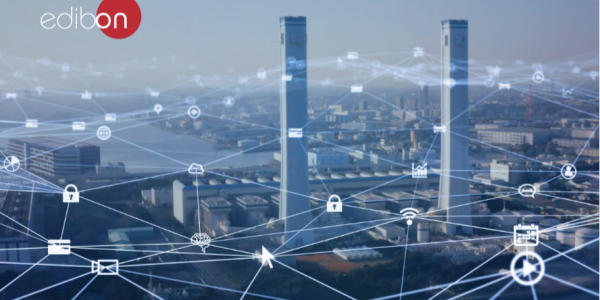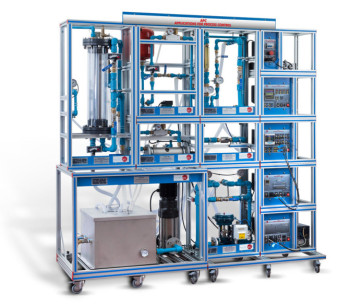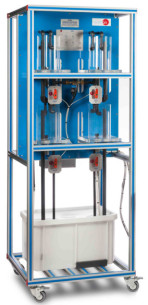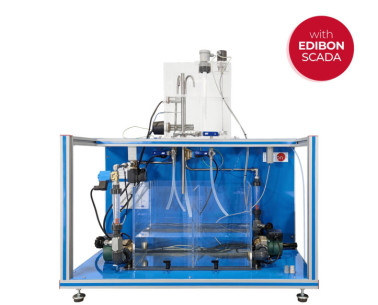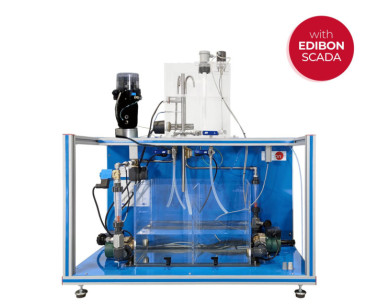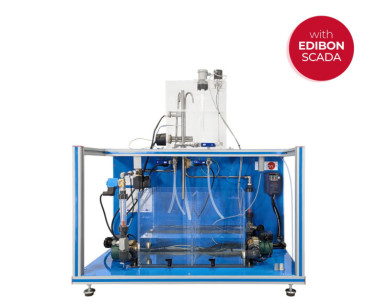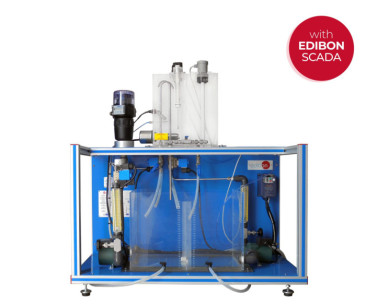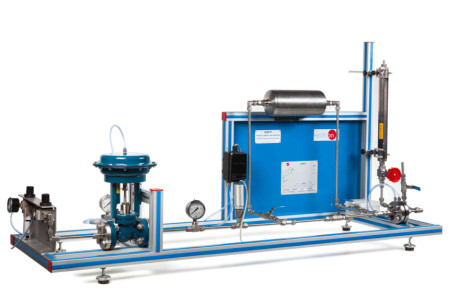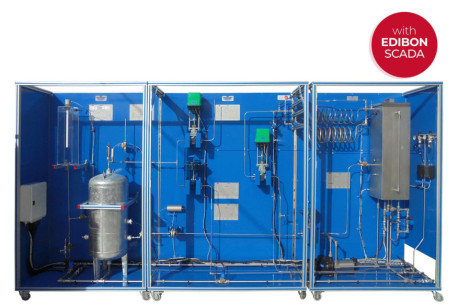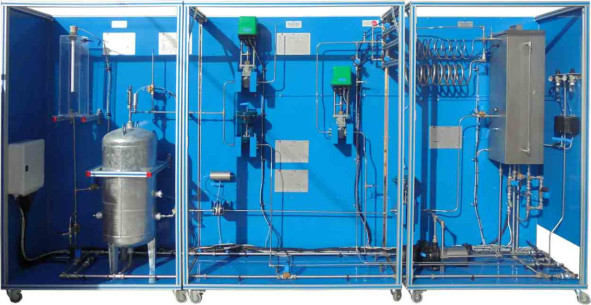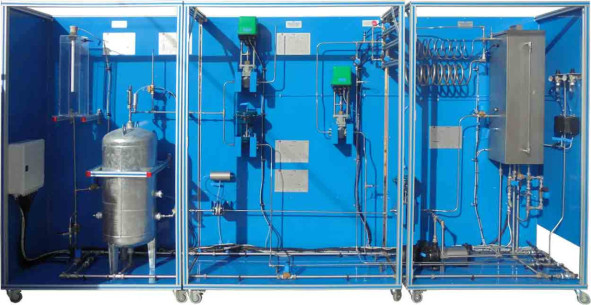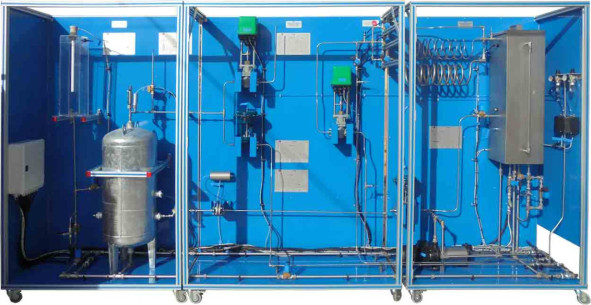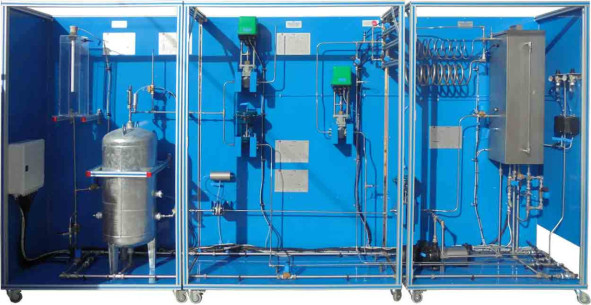The Flow, Level, Pressure and Temperature Process Control Unit, "FLPTU", has been designed by EDIBON to provide practical training in the field of industrial process control, allowing users to understand the fundamentals of control loops and the application of ON/OFF and PID control strategies in real systems.
Within this range, two configurations are available:
- FLPTU/COM. Compact Flow, Level, Pressure and Temperature Process Control Unit.
- FLPTU/MOD. Modular Flow, Level, Pressure and Temperature Process Control Unit.
The "FLPTU/COM" enables the performance of four closed-loop controls: flow, level, pressure, and temperature, combining sensors, actuators, and a real industrial controller to study the dynamic response of the system to different disturbances. The unit consists of several hydraulic and electrical subsystems that work together to reproduce the behavior of a complete industrial process control system. Each subsystem performs a specific function within the different control loops, allowing users to understand both the individual operation of each component and their interrelation within the complete system.
The Cold Water Supply and Recirculation Unit, "CWS", is the starting point of the hydraulic circuit. Its main function is to provide the necessary cold-water flow for the operation of the different control loops. It includes a storage tank with a drain valve, a temperature indicator, and a centrifugal pump whose speed is controlled by the Variable Frequency Drive Module "N-FI/0.6kW", which allows local or remote flow control via a 4–20 mA signal.
The Pneumatic Control Valve, "PCV", acts as the main final control element in the different regulation loops. Through a proportional pneumatic signal, the valve adjusts the water flow according to the process variable to be controlled. Its design, featuring a diaphragm actuator and an I/P converter, ensures a stable and precise response to setpoint changes.
The Flow Measurement and Comparison Unit (Mechatronic Piston and Hall-Effect Paddlewheel), "FMC", allows users to analyze and compare two flow measurement technologies commonly used in industry: a mechatronic piston flow transmitter and a paddlewheel transmitter based on the Hall effect. This unit helps users understand the operating principles, accuracy, and dynamic response of both methods. The output signal is conditioned by the Paddlewheel Flowmeter Module with Current and Frequency Output, "N-SEN52", which converts the frequency signal for processing by the controller.
The Plate Heat Exchanger (Water-to-Water) Unit, "PHE", forms the core of the thermal control system. It enables the study of heat transfer between cold and hot water circuits using a plate heat exchanger equipped with regulating valves, analog flowmeters, and temperature indicators at the inlets and outlets of both flows. This unit is essential for analyzing the thermal dynamics of the entire system and its behavior under different disturbances.
The Hot Water Supply and Recirculation Unit, "HWS", complements the cold-water system, closing the thermal circuit. It maintains a constant flow of hot water through a recirculation pump and expansion tank, also incorporating safety devices such as relief valves, automatic air vents, and pressure indicators. Its integration with the heat exchange circuit allows precise temperature control within the system.
The 2 kW Electric Heating Unit, "EH/2kW", provides the thermal energy required for the hot-water circuit. It consists of an electric heating element controlled by an analog signal and equipped with level and temperature safety protections. Its power is managed by the 2 kW Heating Module," N-H/2kW", which includes a safety temperature controller and a solid-state relay for accurate power regulation.
Finally, the Transparent Pressurized Tank for Pressure and Level Control, "PLPT", enables the study and operation of the level and pressure control loops. This unit, composed of a transparent pressurized tank equipped with pressure and ultrasonic level transmitters, ball valves, relief valves, and analog indicators, allows direct observation of fluid behavior under various operating conditions. Its design lets users analyze the interaction between pressure and level variables and how different control strategies maintain them within their setpoints.
The power supply, control, measurement, and data recording block of the system consists of industrial-grade modules similar to those used in real production environments, including:
- Power Supply Module for Control Circuits Module,"N-ALI20", equipped with magneto-thermal and differential protections, an emergency stop button, and a key switch for safe operation.
- Single Loop Industrial Controller Module, "N-IC-SL" which allows configuration of P, PI, and PID parameters, autotuning, and the setup of advanced mathematical and logical functions and alarms.
- Four-channel Signal Recorder Module, "N-SR-3", which enables real-time data acquisition, visualization, and storage for later analysis.
- Analogs and Digitals Indicators of 4-20 mA, "N-MED87", Current Signals Module, providing direct reading of process variables.
- 8 and 5-Pin Connector Terminal Block Module , "N-TERM", and Paddlewheel Flowmeter Module with Current and Frequency Output, "N-SEN52", dedicated to signal connection and conversion, completing the electrical configuration of the system.
 Cookie preferences
Cookie preferences

